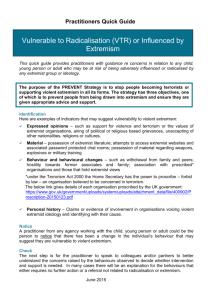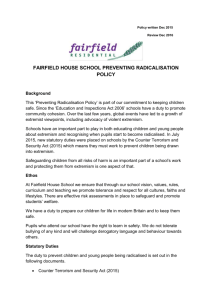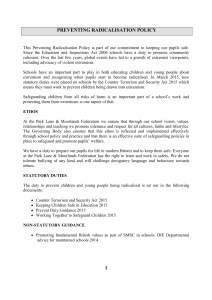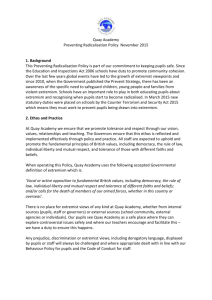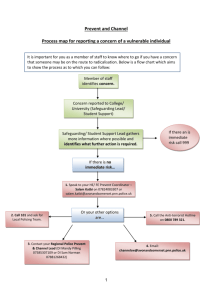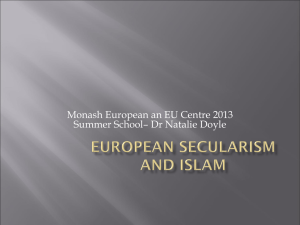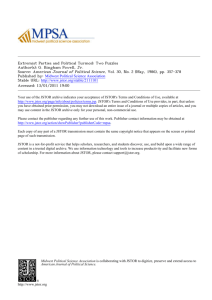Updated February 2015 - The Queen Anne First School Windsor
advertisement
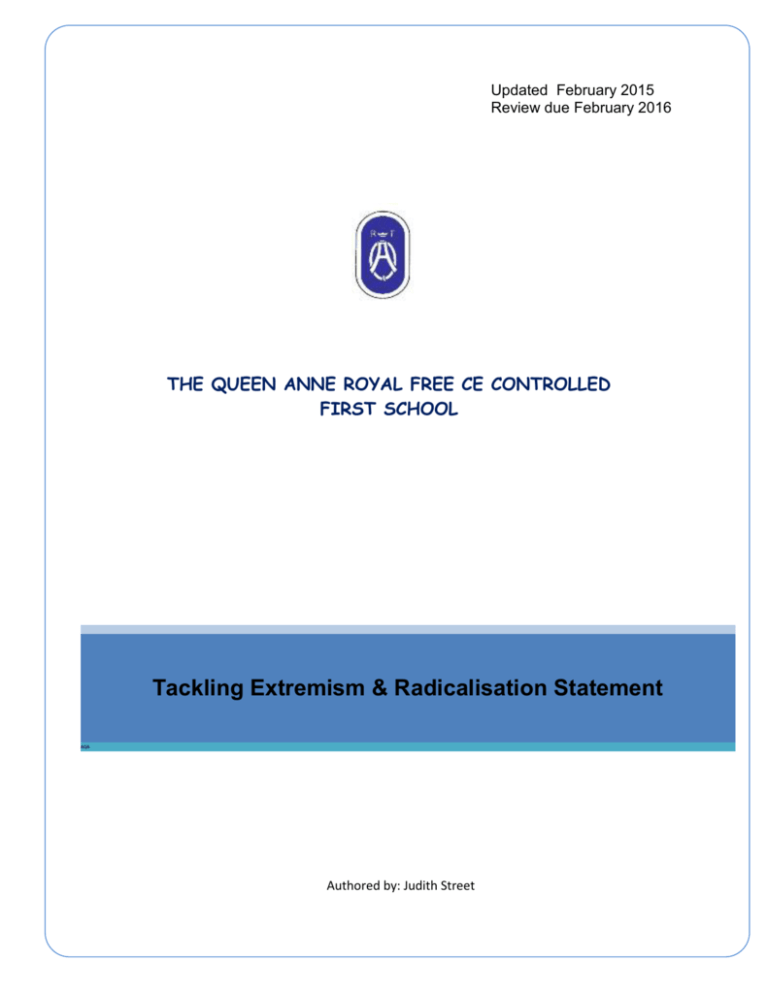
Updated February 2015 Review due February 2016 THE QUEEN ANNE ROYAL FREE CE CONTROLLED FIRST SCHOOL Tackling Extremism & Radicalisation Statement AQA Authored by: Judith Street The school promotes equality and actively challenges all gender, racist, disablist, homophobic and transphobic language and behaviour. Definitions: Radicalisation is defined as the act or process of making a person more radical or favouring of extreme or fundamental changes in political, economic or social conditions, institutions or habits of the mind. Extremism is defined as holding extreme political or religious views. The Queen Anne Royal Free C.E. First School recognise our role in preventing and dealing with radicalisation and extremism. We are committed to safeguarding and promoting the welfare of all pupils. We recognise that safeguarding against radicalisation and extremism is no different to safeguarding against any other vulnerability in today’s society. We recognise that as a school we are well-placed to be able to identify the safeguarding issues linked to radicalisation and extremism, and the appendix to this statement sets out how we work together to prevent such incidents and deal with incidents. We recognise the need for all staff to be vigilant and ‘think the unthinkable’, remain fully informed about the issues which affect the local area, city and the wider society in which we teach. Radicalisation and Extremism is discussed as part of the school’s regular Safeguarding Training and updates. Staff are taught: to be familiar with behavioural indicators ( see appendix 1) to know the procedure for referring concerns. The referral procedures for extremism and radicalisation is the same as for any other safeguarding concern. See Child Protection Policy/procedures. Understand their role and the role of the school in preventing and tackling radicalisation and extremism ( appendix 2) Linked Policies and documents: Safeguarding and Child Protection Policy Equality Policy Anti-bullying Policy Behaviour Management Policy PREVENT Government Strategy Keeping Children Safe in Education DFE 2014 Working Together to Safeguard Children HM GOV 2013 APPENDIX 1 Understanding and Recognising Risks and Vulnerabilities of Radicalisation and Extremism Extremist organisations can develop and popularise ideas which create an environment conducive to violent extremism and terrorism. "In assessing the drivers of and pathways to radicalisation, the line between extremism and terrorism is often blurred. Terrorist groups of all kinds very often draw upon ideologies which have been developed, disseminated and popularised by extremist organisations that appear to be non-violent (such as groups which neither use violence nor specifically and openly endorse its use by others)". [Prevent Strategy 5.34] "Terrorist groups can take up and exploit ideas which have been developed and sometimes popularised by extremist organisations which operate legally in this country.. Evidence also suggests that some (but by no means all) of those who have been radicalised in the UK had previously participated in extremist organisations" (Prevent Strategy - opening summary to chapter 5) Children and young people can be drawn into violence or they can be exposed to the messages of extremist groups by many means. These can include through the influence of family members or friends and/or direct contact with extremist groups and organisations or, increasingly, through the internet. This can put a young person at risk of being drawn into criminal activity and has the potential to cause significant harm. Children and young people are vulnerable to exposure to, or involvement with, groups or individuals who advocate violence as a means to a political or ideological end. Examples of extremist causes that have used violence to achieve their ends include animal rights, the far right, internal terrorist and international terrorist organisations; Most individuals, even those who hold radical views, do not become involved in extremism. Numerous factors can contribute to and influence the range of behaviours that are defined as extremism. It is important to consider these factors in order to develop an understanding of the issue. It is also necessary to understand those factors that build resilience and protect individuals from engaging in violent extremist activity. Safeguarding children and young people from radicalisation is no different from safeguarding them from other forms of harm. Indicators for vulnerability to radicalisation are the same as those you are already familiar with: • family tensions • sense of isolation • migration • distance from cultural heritage • experience of racism or discrimination • feeling of failure etc. Those in the process of being radicalised may become involved with a new group of friends, search for answers to questions about identity, faith and belonging, possess extremist literature or advocate violence actions, change their behaviour and language, seek to recruit others to an extremist ideology. It is important to note that children and young people experiencing these situations or displaying these behaviours are not necessarily showing signs of being radicalised. There could be many other reasons for the behaviour including those you are already familiar with alcohol or drug abuse, family break down, domestic abuse, bullying etc or even something more minor. It is important to be cautious in assessing these factors to avoid inappropriately labelling or stigmatising individuals because they possess a characteristic or fit a specific profile. It is vital that all professionals who have contact with vulnerable individuals are able to recognise those vulnerabilities and help to increase safe choices. Vulnerability • Identity Crisis - Distance from cultural/ religious heritage and uncomfortable with their place in the society around them • Personal Crisis – Family tensions; sense of isolation; adolescence; low self esteem; disassociating from existing friendship group and becoming involved with a new and different group of friends; searching for answers to questions about identity, faith and belonging • Personal Circumstances – Migration; local community tensions; events affecting country or region of origin; alienation from UK values; having a sense of grievance that is triggered by personal experience of racism or discrimination or aspects of Government policy • Unmet Aspirations – Perceptions of injustice; feeling of failure; rejection of civic life • Criminality – Experiences of imprisonment; poor resettlement/ reintegration, previous involvement with criminal groups Access to extremism / extremist influences • Is there reason to believe that the child/young person associates with those known to be involved in extremism - either because they associate directly with known individuals or because they frequent key locations where these individuals are known to operate? (e.g. the child/young person is the partner, spouse, friend or family member of someone believed to be linked with extremist activity) • Does the child/young person frequent, or is there evidence to suggest that they are accessing the internet for the purpose of extremist activity? (e.g. Use of closed network groups, access to or distribution of extremist material, contact associates covertly via Skype/email etc) • Is there reason to believe that the child/young person has been or is likely to be involved with extremist/ military training camps/ locations? • Is the child/young person known to have possessed or is actively seeking to possess and/ or distribute extremist literature/ other media material likely to incite racial/ religious hatred or acts of violence? • Does the child/young person sympathise with, or support illegal/illicit groups e.g. propaganda distribution, fundraising and attendance at meetings? • Does the child/young person support groups with links to extremist activity but not illegal/illicit e.g. propaganda distribution, fundraising and attendance at meetings? Experiences, Behaviours and Influences • Has the child/ young person encountered peer, social, family or faith group rejection? • Is there evidence of extremist ideological, political or religious influence on the child/ young person from within or outside UK? • Have international events in areas of conflict and civil unrest had a personal impact on the child/ young person resulting in a noticeable change in behaviour? It is important to recognise that many people may be emotionally affected by the plight of what is happening in areas of conflict (i.e. images of children dying) it is important to differentiate them from those that sympathise with or support extremist activity • Has there been a significant shift in the child/ young person’s behaviour or outward appearance that suggests a new social/political or religious influence? • Has the child/ young person come into conflict with family over religious beliefs/lifestyle/ dress choices? • Does the child/ young person vocally support terrorist attacks; either verbally or in their written work? • Has the child/ young person witnessed or been the perpetrator/ victim of racial or eligious hate crime or sectarianism? Travel • Is there a pattern of regular or extended travel within the UK, with other evidence to suggest this is for purposes of extremist training or activity? • Has the child/ young person travelled for extended periods of time to international locations known to be associated with extremism? • Has the child/ young person employed any methods to disguise their true identity? Has the child/ young person used documents or cover to support this? Social Factors • Does the child/ young person have experience of poverty, disadvantage, discrimination or social exclusion? • Does the child/ young person experience a lack of meaningful employment appropriate to their skills? • Does the child/ young person display a lack of affinity or understanding for others, or social isolation from peer groups? • Does the child/ young person demonstrate identity conflict and confusion normally associated with youth development? • Does the child/ young person have any learning difficulties/ mental health support needs? • Does the child/ young person demonstrate a simplistic or flawed understanding of religion or politics? • Does the child/ young person have a history of crime, including episodes in prison? • Is the child/young person a foreign national, refugee or awaiting a decision on their immigration/ national status? • Does the child/ young person have insecure, conflicted or absent family relationships? • Has the child/ young person experienced any trauma in their lives, particularly any trauma associated with war or sectarian conflict? • Is there evidence that a significant adult or other in the child/young person’s life has extremist view or sympathies? More critical risk factors could include:• Being in contact with extremist recruiters • Articulating support for extremist causes or leaders • Accessing extremist websites, especially those with a social networking element • Possessing extremist literature • Using extremist narratives and a global ideology to explain personal disadvantage • Justifying the use of violence to solve societal issues • Joining extremist organisations • Significant changes to appearance and/or behaviour APPENDIX 2 How can we reduce the risk of extremism and radicalisation in school? Education can be a powerful tool, equipping children with the knowledge, skills and reflex to think for themselves, to challenge and to debate; and giving young people the opportunity to learn about different cultures and faiths and, to gain an understanding of the values we share. Exploring ideas, developing a sense of identity and forming views are a normal part of growing up. At The Queen Anne Royal Free C.E. First School , we understand our role in raising awareness; providing information; enabling children to make a positive contribution; and safeguarding all our children We work together to reduce the risk of radicalisation and extremism by: Creating explicit value statements that are inclusive of all students Reviewing curriculum and pupil participation and safeguarding processes Developing critical personal thinking skills and using curriculum opportunities including small group work Implementing social and emotional aspects of learning Exploring and promoting diversity and shared values between and within communities Challenging Islamophobia, anti-Semitism and other prejudices Supporting those at risk of being isolated Building ties with all local communities, seeking opportunities for linking with other schools Using anti-bullying strategies to minimise hate and prejudice based bullying Using restorative approaches to repair harm caused We provide a safe environment for discussing controversial issues and helping young people understand how they can influence and participate in decision-making. We encourage children to express their views but also to appreciate the impact their views can have on others, to take responsibility for their actions and to understand that the use of violence to further any cause is criminal We facilitate understanding of wider issues within the context of learning about the values on which our society is founded and our system of democratic government. We recognise that, young people can be exposed to extremist influences or prejudiced views, particular those via the internet and other social media. We help to protect children from extremist and violent views in the same ways that they help to safeguard children from drugs, gang violence or alcohol. We work with other local partners, families and communities, to help support pupils who may be vulnerable as part of our safeguarding responsibilities. We develop cross-curricular dimensions of the curriculum to include– media and technology, the global dimension and sustainable development and identity and cultural diversity. We give children the opportunity to learn about different cultures and faiths and to debate shared values, so as to enable them to become involved in decision-making about important and real issues. We help children to develop knowledge of religion, history, geography, citizenship and start to become critically aware of the role of different media. We also help children to develop the skills to critically evaluate controversial issues. We promote a shared culture of openness and pluralism in the school and with the wider community, regardless of the specific status, location or faith affiliation of the school We see the connections between the learning, teaching and curriculum elements and the other dimensions of a whole school approach. We provide safe places for learners and they provide opportunities for children to meet people from backgrounds other than their own. We use a teaching and learning style which Promotes knowledge, skills and understanding to build the resilience of learners; Explores controversial issues; Recognises local needs; Challenges extremist narratives; Promotes universal rights; promotes critical analysis; and promotes pro-social values. Teaching controversial issues Effectively tackling controversial issues can help learners challenge the perceptions and misconceptions of their own and others’. To do this classroom practices can include: developing questioning techniques to open up safe debate; building confidence to promote honesty about a plurality of views; ensuring freedom of expression and freedom from threat; debating fundamental moral and human rights principles; promoting open respectful dialogue; and affirming multiple identities.
